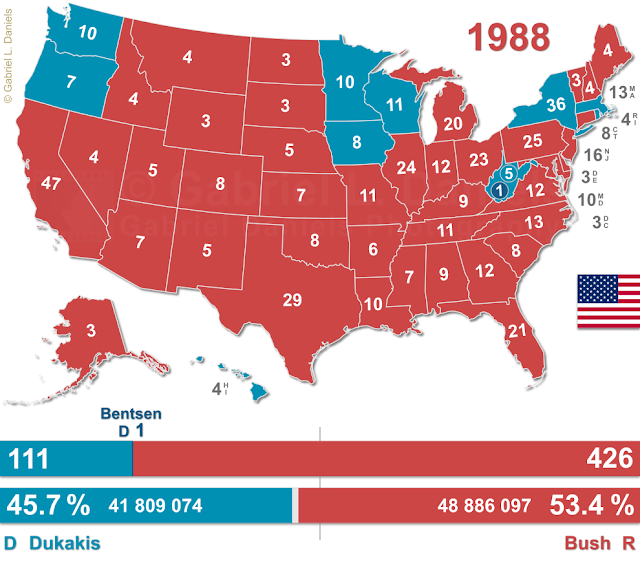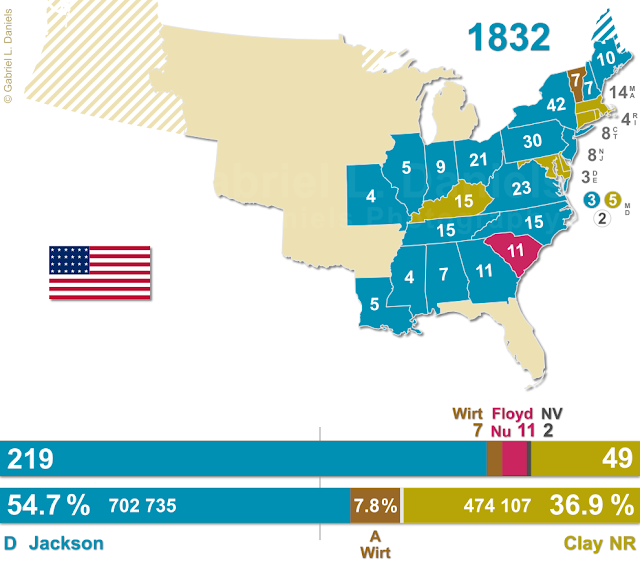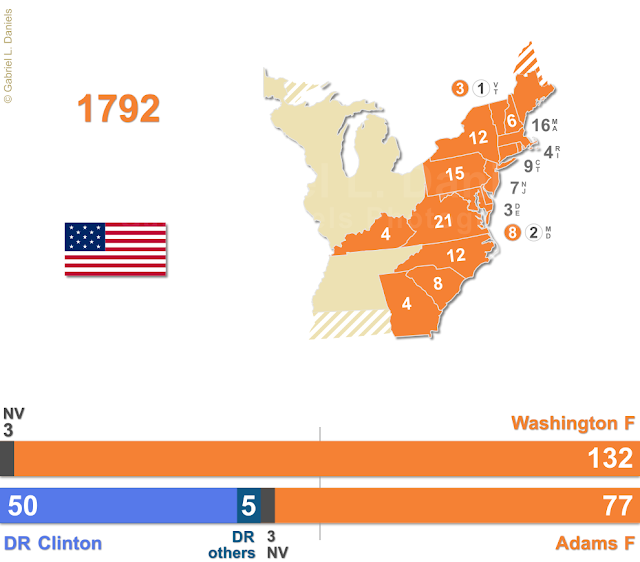United States presidential election maps, 1789 - 2016
See bottom of page for notes.Notes:
States that did not participate or had all of their electors disqualified are shown in white.
Gray numbers and numbers in white cirlces indicate electoral votes not cast.
A slash through a number indicates electoral votes that were disqualified.
Popular vote figures vary by source and should be taken as close approximations. Beginning with 1984, data from the Federal Election Commission is shown.
1789: North Carolina and Rhode Island had not yet ratified the Constitution and therefore did not participate in the election.
1789-1800: The "presidential" electors are shown on the maps and all electors in the pie charts. The top chart is for the "presidential" electors and the bottom chart for the "vice-presidential" electors. The Constitution was amended in 1804 to change Electoral College procedures.
1800 & 1824: No winner in the Electoral College. The election was therefore decided by Congress (the House of Representatives choosing the president on a one state, one vote basis and the Senate choosing the vice president).
1860: Exact popular vote totals for the Northern, Southern, and Fusion Democratic tickets are impossible to establish due to unusual variations in how electors were pledged. The fusion tickets were on the ballot in New Jersey, New York, and Pennsylvania (New Jersey gave Douglas three electors). Some sources omit the fusion tickets and give Douglas 29.5% of the overall popular vote and Breckinridge 18.2%.
1864: Louisiana and Tennessee's electors were disqualified. These states' popular vote is not included in the totals.
1872: Greeley died on November 28th and his electors scattered. Three Georgia electors were disqualified because they voted for Greeley. The electors from Arkansas and Louisiana were disqualified; however, these states' popular vote is included in the totals.
1876: Colorado's electors were appointed by the state legislature. Florida, Louisiana, South Carolina, and one Oregon elector were disputed; Congress awarded all disputed electors to Hayes. Tilden won the nationwide popular vote but lost in the Electoral College.
1888: Cleveland won the nationwide popular vote but lost in the Electoral College
1956 & 1960: Exact popular vote totals for the Democratic candidates are impossible to establish due to unusual election rules in several southern states.
2000: Florida disputed; the state's certification of Bush as the winner was upheld by the United States Supreme Court. Gore won the nationwide popular vote but lost in the Electoral College.
2016: Clinton won the nationwide popular vote but lost in the Electoral College.
Parties:
A: American
AM: Anti-Masonic
AmI: American Independent
CU: Constitutional Union
D: Democratic
DR: Democratic-Republican
DN: Northern Democratic
DS: Southern Democratic
DRF: Democratic-Republican / Federalist
F: Federalist
FS: Free Soil
G: Green
GB: Greenback
Ind: Independent
L: Libertarian
LR: Liberal Republican
Nu: Nullifier
NR: National Republican
P: Progressive
Pop: Populist
Prh: Prohibition
R: Republican
Ref: Reform
S: Socialist
SR: States' Rights
U: Union
W: Whig





























































No comments:
Post a Comment